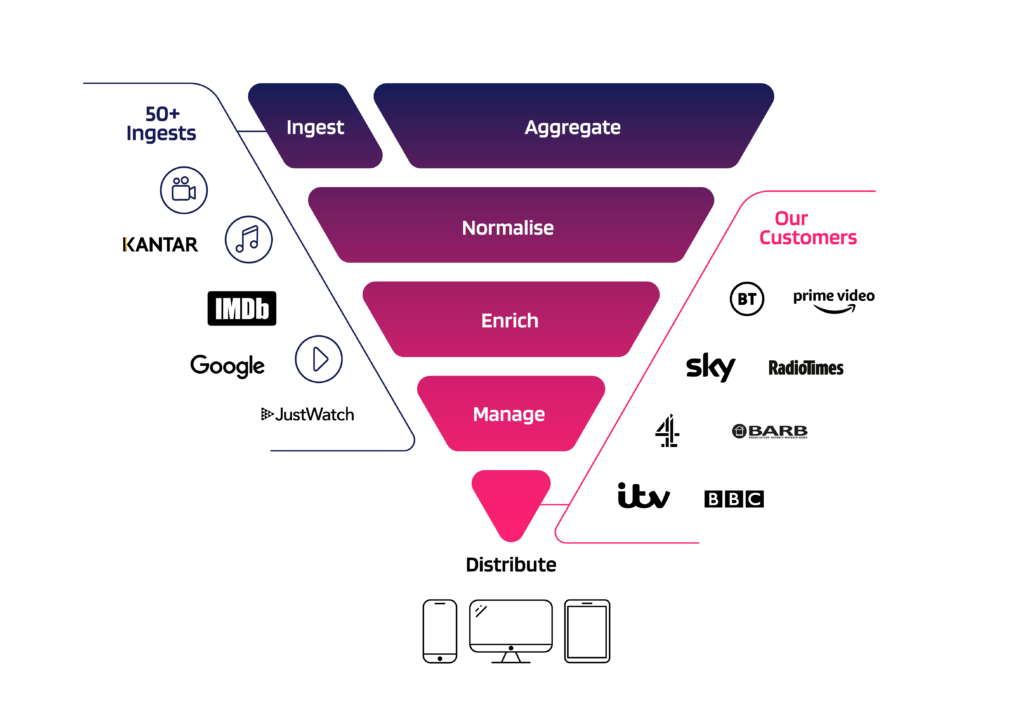
MetaBroadcast: Automated Metadata Done Right
For nearly 15 years, London-based metadata specialist MetaBroadcast has been providing automated metadata solutions for entertainment service providers, with the goal of helping millions of people find the right content more quickly on every available device.
MetaBroadcast’s platform automatically aggregates content from numerous sources as one, putting data to work for platforms and content owners, with nearly 100 percent of linear and on demand viewing covered in the UK, and billions of data points processed every day.
Jamie Mackinlay, CEO of MetaBroadcast, spoke with MESA about the BBC origins of the company, how MetaBroadcast has adapted to constant changes in the science of metadata management and application, and why being “obsessed” with metadata is crucial to the company’s success.
 MESA: What was the impetus for MetaBroadcast, how did the company first come about in 2008?
MESA: What was the impetus for MetaBroadcast, how did the company first come about in 2008?
Mackinlay: MetaBroadcast was born out of the BBC. The BBC, a worldwide innovation trailblazer, was pursuing a strategic project to improve metadata management — particularly aggregation, normalization and enrichment of data from multiple sources. Our founders were former BBC technologists with a deep understanding of metadata, but also the challenges in ensuring that the right data was not only available but also providing the relevant details and context to help viewers easily discover the content they sought.
Looking for answers to these challenges the company was set up to be innovative and an early adopter of technologies including cloud, big data and machine learning. MetaBroadcast as a result achieved a series of industry firsts and awards around the integration of broadcasting and data. Further to that, the company pioneered integration between broadcast and social media, and a wide range of cross-industry data aggregation and analysis techniques.
MESA: How has the science of metadata management (and application) evolved over the years, and, for media and entertainment, what is the industry doing right, and what could it be doing better?
Mackinlay: Data and building the understanding of how to use it to optimize user experiences has always been mission critical. The key difference today, from the past, is the increase in places to watch, the proliferation of content and maintaining accurate and complete metadata from different sources to support these rapidly changing viewing habits.
A key challenge for our customers is that there is no single source of metadata. To provide the consumer with a 360˚ view of content, guides must include metadata aggregated from different sources. However, while it is possible to ingest data from multiple sources, it may not all be formatted in the same way, use a consistent ID schema or include deeplinks – all of which make it difficult to integrate into existing scheduling, recommendation, EPG or other data management platforms.
Most TV service providers license metadata from multiple sources such as Gracenote or IMDb, but there are specialist metadata providers, like MetaBroadcast, with incremental data that adds great value when it comes to content discovery and are highly automated.
Some key trends in data include consumers not only searching for content based on title, actor, or genre, they are increasingly interested based on mood, weather, location and more. The persistent challenge will be to provide the metadata that helps viewers discover and watch the content they want.
 Furthermore, there is not only demand from consumers to discover content more easily, but from broadcasters, streaming providers, publishers, and audience measurement firms to aggregate, normalize and enrich metadata to enhance their existing service capabilities.
Furthermore, there is not only demand from consumers to discover content more easily, but from broadcasters, streaming providers, publishers, and audience measurement firms to aggregate, normalize and enrich metadata to enhance their existing service capabilities.
All of this plus a desire to be highly automated means that the industry does need to embrace standards like EIDR but also see metadata as a valuable investment, not just a cost. Investment in metadata is an important key to unlocking the modern user experiences needed to delight and retain customers. The technology and data know-how are in place we just need to prioritize it.
MESA: Speak to the various products (Columbus, Shaman, Atlas, etc.), and services (support, editorial, development, etc.), that MetaBroadcast offers, and what should media and entertainment players look for from you to solve their metadata needs?
Mackinlay: First, it’s important to note that we are obsessed with metadata. This is our singular focus. We ingest, aggregate, normalize, enrich, manage, and distribute metadata. The foundation of MetaBroadcast’s solution is Atlas. This is our 4th generation cloud-native SaaS platform that acts as the central database and depository for all ingested metadata. Atlas, built on AWS, provides the capabilities to manage and edit text, image, or schedule related metadata; identify and fix malformed, missing, or incorrect data; and index and search our large data warehouse.
Our proprietary algorithms and automated processes streamline data normalization – unifying data from multiple sources. These same tools also allow us to identify opportunities for enrichment where, typically more than 90 percent of the enrichment process is automated and the remainder bringing in human intelligence via our editors.
This efficiency and accuracy give our broadcast, streaming and media customers confidence that the platform can continuously adapt to their market-driven requirements. They benefit from consistent, high-quality metadata while eliminating redundant work processes and minimizing human intervention.
MetaBroadcast also offers specialist professional services to help set up and use Atlas, a full support package, and editorial capabilities.
MESA: What are some of MetaBroadcast’s favourite use-case examples (that you can share), where media and entertainment companies made especially good use of your services?
Mackinlay: We serve a diverse set of customers – each with a different need, but all focused on using metadata to enable discovery. This is the value of an established and scalable cloud-native platform with modular functionality.
We assist tier 1 broadcasters like BBC and Platforms like BT TV where they define the data sources they want while we ingest the data from those sources with the goal to normalize and enrich the data before distributing onward to their in-house platforms.
 We are expanding our relationship with RadioTimes in helping them become an online entertainment hub, by adding SVOD content metadata, deeplinks and data cleansing to the existing linear solution of providing an end-to-end metadata process flow and editorial services for linear content.
We are expanding our relationship with RadioTimes in helping them become an online entertainment hub, by adding SVOD content metadata, deeplinks and data cleansing to the existing linear solution of providing an end-to-end metadata process flow and editorial services for linear content.
We have a long-standing relationship with BARB, the UK’s agnostic audience management service, where broadcaster-defined metadata, Tx logs and VOD content metadata are ingested, aggregated, automatically matched, and enriched to create unique records. Audience measurement figures, including data from Kantar, are aggregated to allow a complete, hierarchical list of programs with detailed classification.
MESA: How has the pandemic impacted your business, in what ways has the company adjusted its services?
Mackinlay: We’ve all seen the figures indicating the rise in video consumption during the pandemic. It’s also reinforced the importance of content discovery. As a company providing a cloud-based solution already, we were easily able to fulfill customer demand and move the team into remote working with zero disruption for our clients.
The pandemic has been a proving ground for our business model and team structure. Our team of data scientists, editors and software engineers were able to work from home and seamlessly delivering the platform updates and enhancements required by our exceptionally loyal customers. Other than losing that office-based collaboration and not being able to spend time with customers in person we have not seen any negative outcomes.
On the people front, I think our team grew closer as part of the shared experience of the pandemic. The company implemented a series of measures to keep our people at the center of our focus and I am delighted to share how brilliantly the team reacted and how supportive they were to each other. Our business is proud of its company culture, and this helped us in those difficult days.
